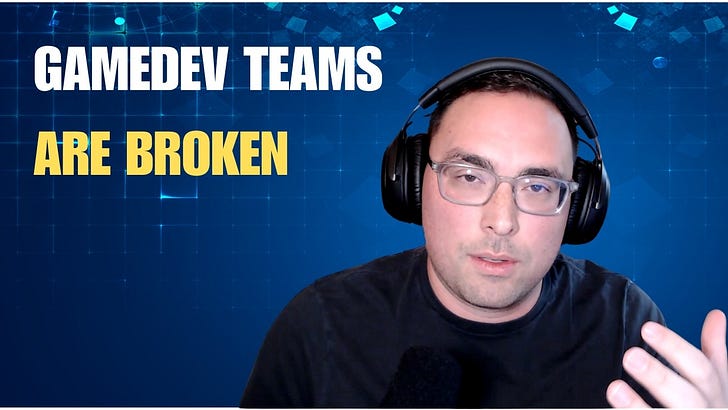Your design team churns out disconnected paper designs. Engineering over-engineers solutions that miss the actual need. Art generates assets without validation, leading to endless iteration and performance issues. QA receives broken builds with unclear requirements, producing bug reports that may or may not matter.
Here’s the uncomfortable truth: It’s probably not a talent problem. It’s a structural problem.
Chris Casanova has seen this pattern repeat across Microsoft Xbox, Mojang, Relic Entertainment, Offworld Industries, and, most recently, Hypixel Studios. And after watching studios shut down and games fail—not from lack of skilled developers, but from organizational friction—he wrote a manifesto that’s challenging how the entire industry thinks about team structure.
The core insight? We’re optimizing for craft silos when we should be optimizing for outcomes.
The Hidden Cost of “Craft-Based” Teams
Traditional game studios are organized by discipline: a centralized design department, an engineering department, or an art department. On paper, it makes sense. In practice, it’s a friction factory.
Here’s what actually happens:
Design creates specs without engineering context → over-engineered solutions that miss the mark
Art produces assets without real-time validation → wasted work and performance nightmares
QA gets tossed half-baked builds → mountains of irrelevant bug reports
Every handoff loses fidelity → the original intent dies in translation
“So many times I’ve seen different teams where there’s so much friction getting in the way of great people. And so much of the root cause is a bad structure. As leaders, we focus on symptoms and not the root cause.” — Chris Casanova
The symptoms look like:
Endless iteration cycles
Communication breakdowns
Misaligned priorities
Teams working at cross-purposes
Features that don’t meet the actual need
But here’s what most studios miss: This isn’t a people problem. It’s a design problem. And just like we iterate on game design, we need to iterate on org design.
The Military Already Solved This Problem
There’s a compelling analogy from Jocko Willink’s Extreme Ownership: Team Boat 6 in Navy SEAL training. They swapped the team leaders of the last-place and first-place boat crews. The last-place team became first place.
Not because the rowers changed. Because the structure and leadership changed.
Chris referenced Team of Teams by General Stanley McChrystal:
“It was so interesting to read that book and hear the similarities between how a squad or fire team in the military is cross-functional, cross-discipline, craft across craft.”
Both books arrive at the same insight: Small, cross-functional units with clear missions and authority to execute vastly outperform larger, specialized departments coordinating through hierarchy.
The military figured this out in Iraq and Afghanistan. Navy SEALs prove it in training. Game studios? We’re still fighting with the old model.
The “Outcome Team” Framework: What Actually Works
Chris advocates for what he calls “outcome-based teams” (others call them cross-functional, cross-disciplinary, or squad-based). Here’s the core structure:
Team Composition: 5-9 People
This isn’t arbitrary. Research on psychological safety shows that 5-9 people is the sweet spot where:
Everyone can contribute meaningfully
Communication overhead stays low
Team cohesion remains strong
Decision-making is fast
“When you get to 10, 12, 15 people on a team, that’s when you start to see cliques form. People start to fade into the background. That’s when you need to split.”
Cross-Disciplinary by Design
Each team should have everything they need to achieve their outcome:
Designer(s)
Engineer(s)
Artist(s)
Producer
QA embedded (not a separate function)
The key principle: Minimize handoffs. Maximize collaboration.
Clear Mission and Charter
Every team needs to know:
What is their outcome? (Not just “build a feature” but “achieve this player experience”)
Why does it matter? (How it ladders to the game vision)
What are the success metrics? (Specific, measurable KPIs)
Real Example: The Procedural Worlds Team
Chris shared a concrete example from his work on procedurally generated games:
Team Mission: “Every new world seed feels fresh, readable, and performant. Traversal and discovery naturally surface points of interest, resources, and risks.”
The KPI: Biome novelty per minute/hour — How often does a player experience something genuinely new?
The Team:
Procedural generation engineers
World designers
Environment artists
Technical artists (for performance)
Embedded QA
This team has everything they need to own procedural generation from concept to shipping. No handoffs to a separate “tools team,” “art department,” or “QA department.”
The result? They can iterate rapidly, validate in real-time, and actually ship features that work.
Compare this to the traditional model:
Design writes spec for procedural worlds
Engineering builds tech (maybe over-engineers)
Art creates assets (maybe they don’t perform)
QA tests (finds issues late)
Everyone iterates (slowly, painfully)
Traditional model timeline: 6-12 months of painful iteration
Outcome team timeline: 2-4 months with continuous validation
The Three Layers of Team Organization
Chris recommends structuring your studio in three layers:
Layer 1: Product Pillars (3-7 per game)
These are your major experiential areas. For a co-op shooter, this might be:
Combat Systems
Progression & Economy
Social & Co-op Features
Live Operations
Technical Foundation
Layer 2: Outcome Teams (multiple per pillar)
Each pillar contains 2-5 outcome teams. For Combat Systems:
Weapons & Gunplay Team
Enemy AI & Behavior Team
Abilities & Special Moves Team
Layer 3: Individuals (5-9 per team)
Each outcome team has 5-9 people with mixed disciplines, focused on specific outcomes.
“This gives clarity. Everyone knows what pillar they’re supporting, what outcome they’re driving, and who their teammates are.”
The Leadership Challenge: Why This Is Hard
Here’s where it gets uncomfortable. Chris is blunt about why studios resist this structure:
The Territorial Leader Problem
The scenario: A Lead Engineer who’s built their identity around managing a 30-person engineering department.
Shifting to outcome teams means their empire shrinks. They go from managing 30 people to maybe being on one team of 8 people, or leading 2-3 engineers across multiple teams.
“I’ve seen so many cases where someone’s identity is I’m the lead of this entire department. And then you tell them, actually, we’re going to distribute you across these teams. That is a very tough conversation.”
The hard truth: Some leaders won’t make the transition. They’ll resist, politick, or self-select out. And that’s okay—because holding onto territorial structures to preserve egos is how studios fail.
The “Craft Excellence” Pushback
Another common objection: “But who maintains our craft standards? Who ensures engineering excellence if engineers are distributed?”
Chris’s answer: Communities of practice.
Engineers still meet regularly to discuss patterns, standards, and technical debt. Artists still have art reviews. But day-to-day, they work embedded in outcome teams.
This is how Spotify, Netflix, and Google organize. Gaming isn’t special—we just think we are.
The Political Reality
The biggest barrier isn’t technical. It’s political.
“If you have a c-suite that’s divided on this or a board that’s divided, you’re not going to be able to make this change. You need unified leadership saying, ‘This is the direction we’re going.’”
This requires:
Executive alignment
Willingness to have tough conversations
Accepting that some people will leave
Committing to the long-term health of the studio over short-term comfort
What About Small Teams?
Question that came up: “What if you’re only 10 people total?”
Chris’s answer: Don’t overthink it.
At 10 people, you already have the benefits of a small team—transparency, fast communication, scrappiness. You don’t need to create sub-teams.
Instead:
Ensure everyone understands the product vision
Maybe split into two mini-teams focused on in-game vs. out-of-game
Track progress against clear outcomes
Keep the structure flat and collaborative
The principle matters more than the prescription. Apply the framework to your context, don’t follow it blindly.
The AA Co-Op Shooter Example
Chris provided a specific organizational structure for a hypothetical AA co-op shooter with 70 people:
Product Pillars (6 total):
Combat & Gameplay Systems (15 people, 2 teams)
Weapons & Abilities Team (8)
Enemy AI & Combat Flow Team (7)
Progression & Economy (10 people, 2 teams)
Player Progression & Rewards Team (5)
In-Game Economy & Shop Team (5)
Social & Co-Op Features (12 people, 2 teams)
Matchmaking & Lobbies Team (6)
Co-Op Mechanics & Communication Team (6)
Content & Live Ops (15 people, 2 teams)
Seasonal Content Team (8)
Events & Limited-Time Modes Team (7)
World & Narrative (10 people, 1 team)
Environment, Story, & Mission Design Team (10)
Technical Foundation (8 people, 1 team)
Platform, Infrastructure, & Tools Team (8)
Key insights from this structure:
Combat is the priority → Gets the most people (15) and focus
Technical foundation is lean → 8 people supporting 70 (strong engineering culture)
Each team has clear outcomes → Not “build a feature” but “deliver this player experience”
Natural collaboration points → Teams that need to work together are obvious
Scales well → Can add teams within pillars as needed
Compare this to a traditional structure:
Traditional:
20 engineers (reporting to Lead Engineer)
15 artists (reporting to Art Director)
12 designers (reporting to Creative Director)
10 QA (reporting to QA Manager)
With this structure, every feature crosses all four departments. Handoffs everywhere. Misalignment guaranteed.
The Implementation Roadmap
So you’re convinced. How do you actually make this change? Chris offers practical advice:
Step 1: Get Executive Alignment
This is non-negotiable. If your C-suite isn’t unified, don’t bother. You’ll just create chaos.
Present the case with data (friction points, missed deadlines, quality issues)
Show examples from other industries
Get commitment to support tough decisions
Step 2: Start with a Pilot
Don’t reorganize the entire studio overnight.
Pick one team or one feature area
Restructure it as an outcome team
Run it for 3-6 months
Measure results (velocity, quality, team satisfaction)
Learn and iterate
Step 3: Communicate Relentlessly
People fear change. Over-communicate:
Why you’re making this change
What it means for individuals
What stays the same (craft communities)
What success looks like
Step 4: Prepare for Attrition
Some people won’t make it.
Territorial leaders who can’t adapt. Individual contributors who thrived in silos but struggle in cross-functional teams.
“This is where leadership has to have some fortitude and say, ‘We’re doing what’s right for the long-term health of the studio.’”
Step 5: Build New Rituals
Cross-functional teams need different rituals:
Daily standups (across disciplines)
Sprint planning with the whole team
Retrospectives focused on outcomes, not just tasks
Regular syncs between teams within a pillar
The Broader Industry Context
Here’s why this matters right now:
The gaming industry is in crisis. Studios are shutting down. Games are failing despite talented teams. Competition is brutal.
We’re operating in an attention economy where 10,000+ games launch per year. Players have infinite options. Your game has to be exceptional.
You can’t afford organizational friction.
Every week spent in alignment meetings instead of building is a week your competitor gains on you. Every miscommunication that leads to wasted assets is money you can’t get back.
“It’s a little bit egotistical to think that we shouldn’t be having introspection about how we operate. The way game development has been done for years is being blindly followed without adapting for the new environment.”
The studios that will survive are the ones that:
Eliminate friction
Move faster
Iterate more effectively
Ship quality on budget
And that starts with structure.
Key Takeaways
If you only remember five things from this conversation:
Structure is strategy. How you organize your teams determines your outcomes more than individual talent.
Go cross-functional. Teams of 5-9 people with mixed disciplines and clear outcomes beat specialized departments every time.
Minimize handoffs. Every handoff loses fidelity. Give teams everything they need to own their outcomes.
Leadership must commit. Half-measures fail. Territorial resistance will kill this. You need unified executive support.
Apply the principles, not the prescription. A 10-person indie team needs a different structure than a 200-person AAA studio. Think about your context.
The uncomfortable truth? Most studio failures aren’t about a lack of talented developers. They’re about putting talented developers in structures that create friction instead of flow.
And that’s on leadership to fix.
Chris Casanova is currently seeking his next production leadership role where he can help teams find their rhythm. If your studio is ready to think differently about structure, you can reach him on LinkedIn or at Chris.Casanova@outlook.com.
Read Chris’s full article: “Structure Teams to Win” on Medium
**Watch the full conversation with Chris Casanova here:**
He goes deeper into implementation challenges, handling resistant leadership, and specific questions about scaling these principles to different studio sizes.
About Chris Casanova: Chris has spent his career as a producer and product leader across Microsoft Xbox, Mojang (Minecraft), Relic Entertainment, Offworld Industries, Misfits Gaming Group, and Hypixel Studios. He specializes in helping game development teams eliminate friction, find their rhythm, and ship great games.











